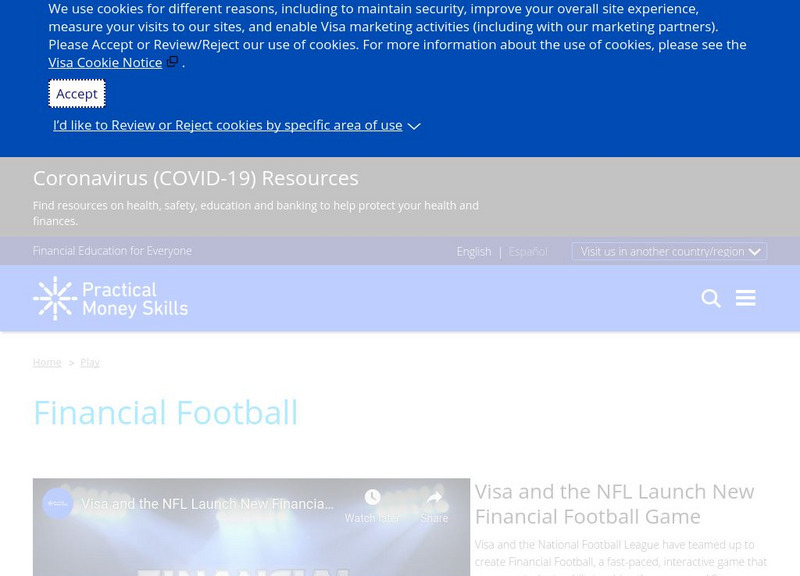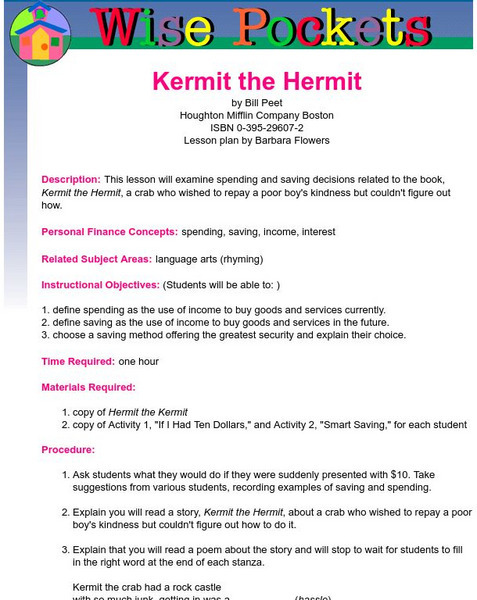Scholastic
Scholastic: Adventures in Math: Lesson 1: Saving Money for Your Future
Tips for learning the value of saving money to achieve your financial goals.
Other
Credit Union National Assoc.: Googolplex: The Cu Guide for Student Money Makers
A comprehensive site about saving money, with information on history of credit unions, money words, games about money, and more. Enter one of the three areas, each targeting a different age level.
Council for Economic Education
Econ Ed Link: Buy a Bond, James: A Lesson on Us Savings Bonds
This site is extremely informative for teaching children the value of saving money. "You will write a persuasive letter telling why people use savings bonds as a way to save their money."
Other
Finra Investor Education Foundation: Introduction to Earning Interest 11 & 12
Students will know and be able to use the formula for calculating compound interest and understand the effect of compounding on savings in this instructional activity.
Council for Economic Education
Econ Ed Link: A Penny Saved Is a Penny at 4.7% Earned
This is a lesson from EconEdLink where students learn about saving money. Includes activities and materials.
Council for Economic Education
Econ Ed Link: Banking Is Interest Ing!
Banks are important to Americans. We use banks to save money and earn interest, or borrow money and pay interest. This lesson introduces the concepts of banking to children.
Council for Economic Education
Econ Ed Link: Climbing the Savings Mountain
Students discover how saving money can be compared to a mountain climb. The climb can be fast or slow, safe or hazardous, scenic or thrilling. You will find out that there is more than one way to get to the top!
Other
Treasury Direct: Money Math: Secret of Becoming a Millionaire [Pdf]
This lesson focuses on understanding fractions, decimals and percentages as the math skills, and saving money and compounding interest as the economic skills. [PDF]
University of Missouri
University of Missouri: Wise Pockets: Berenstain Bears' Trouble With Money
Using a Berenstain Bears' book, students are introduced to concepts such as spending, goods, services, income, saving, and interest. Lesson is detailed and has good activities. Includes questions about the story that teach students about...
Practical Money Skills
Visa: Practical Money Skills for Life: Financial Football
Football-themed game tests your consumer-finance aptitude regarding interest, banking, credit, budgeting, saving, and spending.
University of Nebraska Omaha
University of Omaha: Why We Save [Pdf]
Why do people need to save money? This lesson plan is geared for Kindergarten through 2nd grade and helps students understand the reasons for saving.
Math Is Fun
Math Is Fun: Interest (An Introduction)
What is interest? What is the difference between simple interest and compound interest? Find the answers to these questions, learn how to calculate interest for a loan, and see how interest can help your money grow. Includes ten practice...
Consumer Financial Protection Bureau
Consumer Financial Protection Bureau: Saving for Post Secondary Education
Students use an online compound interest calculator to answer questions and create charts that show the value of saving money over time for future education goals.
Council for Economic Education
Econ Ed Link: Show Me the Money!
Students will investigate unforeseen costs of car loans and/or house loans. They will then evaluate the economics of decision making, the ramifications of their choices, and options available to them. Students will compute costs and...
Federal Reserve Bank
Federal Reserve Bank of Atlanta: Saving and Investing
Explains the Rule of 72 with examples of compound interest and its power to help grow students' money.
Thinkport Education
Maryland Public Television: Sense and Dollars
Engaging, fun tutorials and interactive games related to earning, spending, saving, and budgeting money.
Federal Reserve Bank
Federal Reserve Bank of St. Louis: Less Than Zero [Pdf]
This lesson accompanies a story by Stuart J. Murphy called Less Than Zero and teaches young scholars about how to manage their money by saving it and setting goals for themselves.
Other
Money Management International: The Berenstain Bears' Trouble With Money
A lesson plan featuring the Berenstain Bears that introduces the concepts of spending, goods, services, income, saving, and interest.
Discovery Education
Discovery Education: Money: Kids and Cash
This site provides a lesson plan about the dynamics of saving and borrowing with banks.
Council for Economic Education
Econ Ed Link: Big Banks, Piggy Banks
Use this informative economics lesson plan. Find out how to save your money. "You will read about safe places for keeping money; you also will learn about places where money can earn money."
ClassFlow
Class Flow: Checking and Savings Accounts
[Free Registration/Login Required] Practical Mathematics begins with the basic checking and savings account and how to reconcile a checking account statement. Simple and compound interest are demonstrated in this step by step flipchart.
Texas Instruments
Texas Instruments: Math Today for Ti Navigator System College Costs Surge
During this activity, students will explore the expected cost of college and also look at methods of saving money for the future. Comparing simple and compound interest will help students make decisions about their future. Students will...
Council for Economic Education
Econ Ed Link: Big Banks, Piggy Banks
When choosing a place to put their money, people consider how safe there money will be, how easy it is to access, and whether it will earn more money. Students explore how well different savings places achieve these objectives. This...
University of Missouri
University of Missouri St. Louis:wise Pockets: Kermit the Hermit
This is an elementary level lesson that deals with spending, saving, income, and interest. Requires the book Kermit the Hermit by Bill Peet. Includes detailed lesson plan along with procedures and activities.















